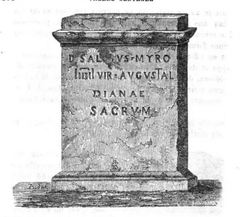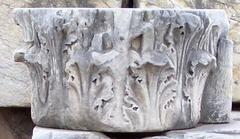
Visiting the Arch of Augustus in Aosta: Hours, Tickets, and Travel Tips
Date: 03/07/2025
Introduction
Nestled amid the Italian Alps, the Arch of Augustus in Aosta is one of the most significant remnants of Roman civilization in northern Italy. Erected in 25 BCE, this monumental gateway commemorates Emperor Augustus’s victory over the Salassi tribe and marks the founding of Augusta Praetoria Salassorum, present-day Aosta. More than a triumphal arch, it is a powerful symbol of Roman expansion and engineering, standing at the strategic junction of Alpine passes that once connected Italy to Gaul.
This comprehensive guide covers the Arch’s historical background, architectural features, and evolving role through the centuries. It also provides up-to-date visitor information, including hours, ticketing, accessibility, guided tour options, and travel tips. Whether you are a history enthusiast, a cultural traveler, or simply curious about Aosta’s ancient legacy, this article will help you plan an enriching visit to the “Rome of the Alps.”
For further reading and visitor tips, see Indagini e Misteri’s exploration of Augusta Praetoria, Italy Magazine’s feature on Aosta’s Roman town, and the official Italia.it guide to Aosta’s Roman ruins.
Table of Contents
- Introduction
- Roman Conquest and the Founding of Aosta
- Architectural Features and Symbolism
- Historical Evolution and Conservation
- Visiting Information: Hours, Tickets, Accessibility
- Getting There and Nearby Attractions
- Guided Tours and Special Experiences
- Best Times to Visit and Photography
- Frequently Asked Questions (FAQ)
- Summary and Visitor Recommendations
- References and Further Reading
Roman Conquest and the Founding of Aosta
Strategic Importance of the Alpine Region
Aosta’s location has been pivotal for millennia. The convergence of the Great and Little St. Bernard passes made it a key corridor for trade and military campaigns between Italy and Gaul. The Romans recognized the value of controlling these Alpine routes, vital for moving armies, goods, and information across the mountain barrier (bellasboldadventures.com; indaginiemisteri.it).
The Conquest of the Salassi
Before Roman occupation, the Salassi tribe—an ancient Celtic people—dominated the valley, leveraging its resources and controlling regional trade. Persistent Roman campaigns against the Salassi culminated in a decisive victory in 25 BCE, when the Romans deported or enslaved much of the population and established Augusta Praetoria Salassorum as a new colony (indaginiemisteri.it).
Urban Planning and Romanization
Aosta was laid out as a classic Roman city, with a grid plan centered on the decumanus maximus (east-west street) and cardo maximus (north-south street), intersecting at the forum. The city was fortified with robust walls, towers, and monumental gates like the Porta Praetoria. These structures, alongside public buildings such as baths, theaters, and temples, reflected the swift Romanization of the region (bellasboldadventures.com).
The Arch of Augustus: A Monument to Victory
The Arch of Augustus, completed in 25 BCE, stood at the entrance to Augusta Praetoria, along the Via delle Gallie. Its imposing form was designed to awe travelers and residents alike, marking the transition from the Alpine wilderness into the ordered world of Rome (indaginiemisteri.it).
Architectural Features and Symbolism
Structure and Style
The arch stands nearly 12 meters high and approximately 9 meters wide, composed of locally sourced conglomerate stone. Its single, barrel-vaulted archway is flanked by ten half-columns with Attic bases and Corinthian capitals. Above, a Doric entablature with triglyphs and metopes reflects the blending of classical architectural orders—an emblem of Roman harmony and authority (tascapan.com; italyweloveyou.com).
Decorative Elements
Originally, the arch was adorned with bas-reliefs and bronze inscriptions extolling Augustus’s achievements. Although many of these decorations have weathered away, surviving fragments and statuary once celebrated Rome’s military victories and imperial ideology (italia.it; lovevda.it).
A slate roof, added in 1716, distinguishes the arch from other Roman monuments and has aided its preservation (italyweloveyou.com).
Symbolic Role
As a triumphal arch, its function was both practical—marking the city’s threshold—and propagandistic, reinforcing the legitimacy of Augustus and the new Roman order (italymagazine.com; tascapan.com).
Historical Evolution and Conservation
Medieval and Modern Transformations
During the Middle Ages, the arch became known as “Saint-Vout,” housing religious imagery and serving as a protective symbol for the city. The structure was incorporated into defensive walls, and its attic was removed in the 18th century. Restoration campaigns in the 18th and 20th centuries secured the monument’s stability and preserved its Roman masonry (lovevda.it; mywanderlustylife.com).
Ongoing Preservation
Recent efforts focus on structural reinforcement and cleaning, ensuring the arch remains accessible while retaining its ancient character. The addition of the slate roof, though not original, has been vital for its preservation (tascapan.com).
Visiting Information: Hours, Tickets, Accessibility
Visiting Hours: The Arch of Augustus is an open-air monument accessible 24/7. There are no set opening or closing times, making it ideal for spontaneous visits (TravelInsighter; BimbeinViaggio).
Tickets: Entry is free. Special guided tours or events may require advance booking and a fee.
Accessibility: The monument stands at street level with paved and mostly even surfaces, suitable for wheelchairs and strollers. Some areas have cobblestones, so visitors with reduced mobility should exercise caution (BimbeinViaggio).
Facilities: While there are no on-site restrooms or cafés, amenities are readily available in the city center, a short walk away.
Getting There and Nearby Attractions
Location: The arch stands at the eastern edge of Aosta’s historic center, near the Buthier River and the Roman bridge. Its prominent setting marks the beginning of an itinerary through the city’s major Roman sites (Wikipedia).
By Foot: Aosta’s old town is compact and pedestrian-friendly. The arch is easily reached via Via Sant’Anselmo or Via Porta Praetoria.
By Car: Parking lots are located just outside the pedestrian zone. From there, it’s a short walk to the monument.
By Public Transport: The city is served by regional trains and buses; the main stations are about 1 km from the arch, with a pleasant walk through the historic center (TravelToItalyGuide).
Nearby Attractions:
- Porta Praetoria: The main Roman gate, dating to 25 BCE (TheIndependentTourist).
- Roman Theater: One of Italy’s best-preserved ancient theaters (BimbeinViaggio).
- Collegiate Church of Saint Ursus: A medieval complex with Romanesque cloister and crypt (GuidaTuristicaAosta).
- Regional Archaeological Museum: Offers exhibits on Roman and local history (TravelToItalyGuide).
- Piazza Chanoux: The city’s main square, with shops and cafés.
Guided Tours and Special Experiences
Guided tours can be booked through local tourism offices. Many include the Arch of Augustus, Roman Theater, and Porta Praetoria, with knowledgeable guides providing context on Roman and medieval Aosta. Some tours offer augmented reality features or audio guides for independent exploration (GuidaTuristicaAosta; TravelInsighter).
Informational signs in Italian and English are placed near the arch, and the Regional Archaeological Museum provides additional resources for deeper study.
Best Times to Visit and Photography
The arch is accessible year-round. Milder weather in spring and autumn offers the most comfortable experience and fewer crowds. Early morning and late afternoon provide optimal lighting for photography. Winter visits offer dramatic views of the snow-capped Alps, while summer coincides with open-air events and festivals (TravelToItalyGuide).
Frequently Asked Questions (FAQ)
Q: What are the Arch of Augustus visiting hours?
A: The monument is accessible 24/7 as it is located in a public area.
Q: Is there an entrance fee?
A: No, visiting the Arch of Augustus is free of charge.
Q: Are guided tours available?
A: Yes, local tourism offices offer guided and self-guided tours, sometimes including augmented reality features.
Q: Is the site accessible for visitors with reduced mobility?
A: The area is mostly level and suitable for wheelchairs and strollers, though some cobblestones may be uneven.
Q: Are there visitor facilities on-site?
A: No, but amenities such as restrooms and cafés are available in the nearby city center.
Summary and Visitor Recommendations
The Arch of Augustus is an enduring symbol of Aosta’s Roman origins and ongoing cultural vitality. Its imposing form, harmonious architecture, and central location make it a must-see for visitors of all ages. With free, around-the-clock access and proximity to other major Roman and medieval sites, the arch is an excellent starting point for exploring Aosta’s layered history.
To enhance your visit:
- Plan your trip in spring or autumn for pleasant weather.
- Wear comfortable shoes for walking on cobblestones.
- Pair your visit with nearby attractions for a comprehensive experience.
For more in-depth information, see curated guides such as Tasca Pan’s detailed sight overview, TravelInsighter’s visitor tips, and Love VDA’s heritage database.
References and Further Reading
- When Ancient Rome Met the Alps: My Journey Through Aosta’s Roman Past (Bellas Bold Adventures)
- Augusta Praetoria: The Roman Aosta (Indagini e Misteri)
- The Arch of Augustus: Sight Overview (Tasca Pan)
- Aosta’s Roman Town: History and Visitor Tips (Italy Magazine)
- Arch of Augustus - Heritage Database (Love VDA)
- Visiting Aosta: Walking Itinerary and Map (Bimbein Viaggio)
- Aosta Tourist Guide (Guida Turistica Aosta)
- What to See in Aosta: 1 Day Guide (Travel To Italy Guide)
- The Town of Aosta: Rome of the Alps (The Independent Tourist)
- Visiting Aosta: Hidden Gems (TravelInsighter)
- Aosta Valley: Roman Ruins (Italia.it)
- Aosta Valley, Italy (Italy We Love You)
- 1 Day in Aosta, Italy (My Wanderlusty Life)
- Things to Do in Aosta, Italy (Tourist Bee)


